
One of Professor Christopher Murray’s main research interests is the relationship between comics and literature, and especially the process of adaptation. He delivers a level 3 English module, ‘The Pictured Page – Literature to Comics’, which explores this theme, has published research on this subject, and has co-created several comics that adapt or respond to literary works. As Murray notes,
In recent years I have developed a practice-based aspect to my research. This involves commissioning comics artists to create artwork based on scripts that I write. Many of these have been adaptations from literature. The thing that I am most interested in is the process of translating literary effects from one medium to another. Any process of adaptation is one of transformation and is implicated in a critical and creative response to the source text. I am fascinated by the process of collaborating with artists to discover ways to find the comics equivalent to the conventions and techniques employed in literary texts. Often this process means being in dialogue with adaptations of these texts in other mediums, such as film, television, theatre, and video games. Creating comics as a mode of practice research provides great insights into the process of adaptation, and it is very informative and exciting to collaborate with fantastic comics creators on these projects.
This page gives a brief description of these projects, alongside links to the comics and references to some related research outputs.
Mary Shelley’s Frankenstein
In 2015, as part of the Being Human Festival, the University of Dundee hosted a series of events linked to Mary Shelley’s Frankenstein (1818), with particular emphasis on the time Mary Shelley spent in Dundee as a teenager. One of the outputs was a comic, Mary Shelley’s Dundee, or Frankenstein Begins, written by Murray and with artwork by local comic artist Norrie Millar, with contributions from Phillip Vaughan, Daniel Cook and Rebecca Horner. This was launched at The McManus Art Gallery and Museum and was accompanied by a performance of the comic. The play, written by Murray, was directed by Gillian Hunter and performed by actors from The Little Theatre and students from Dundee and Angus College’s Acting and Performance course, echoing that fact that the novel was initially adapted into a play.
The first half of the story imagines that Mary Shelley (then Godwin) saw much in Dundee that might have inspired her writing, something that she alludes to in the preface of the 1831 edition of the novel. The second half of the story shows Mary haunted by nightmare visions as the creature takes hold of her imagination.
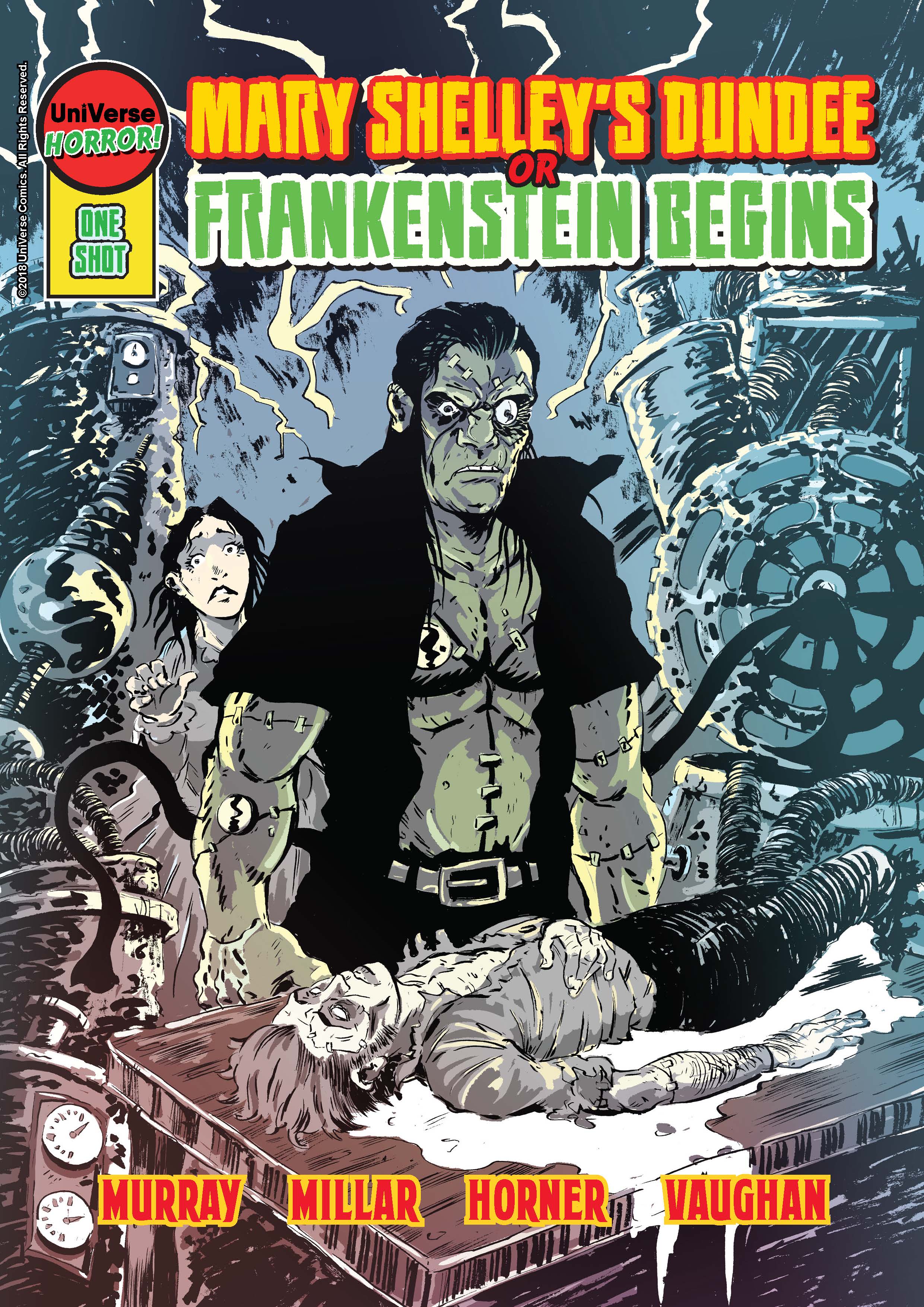
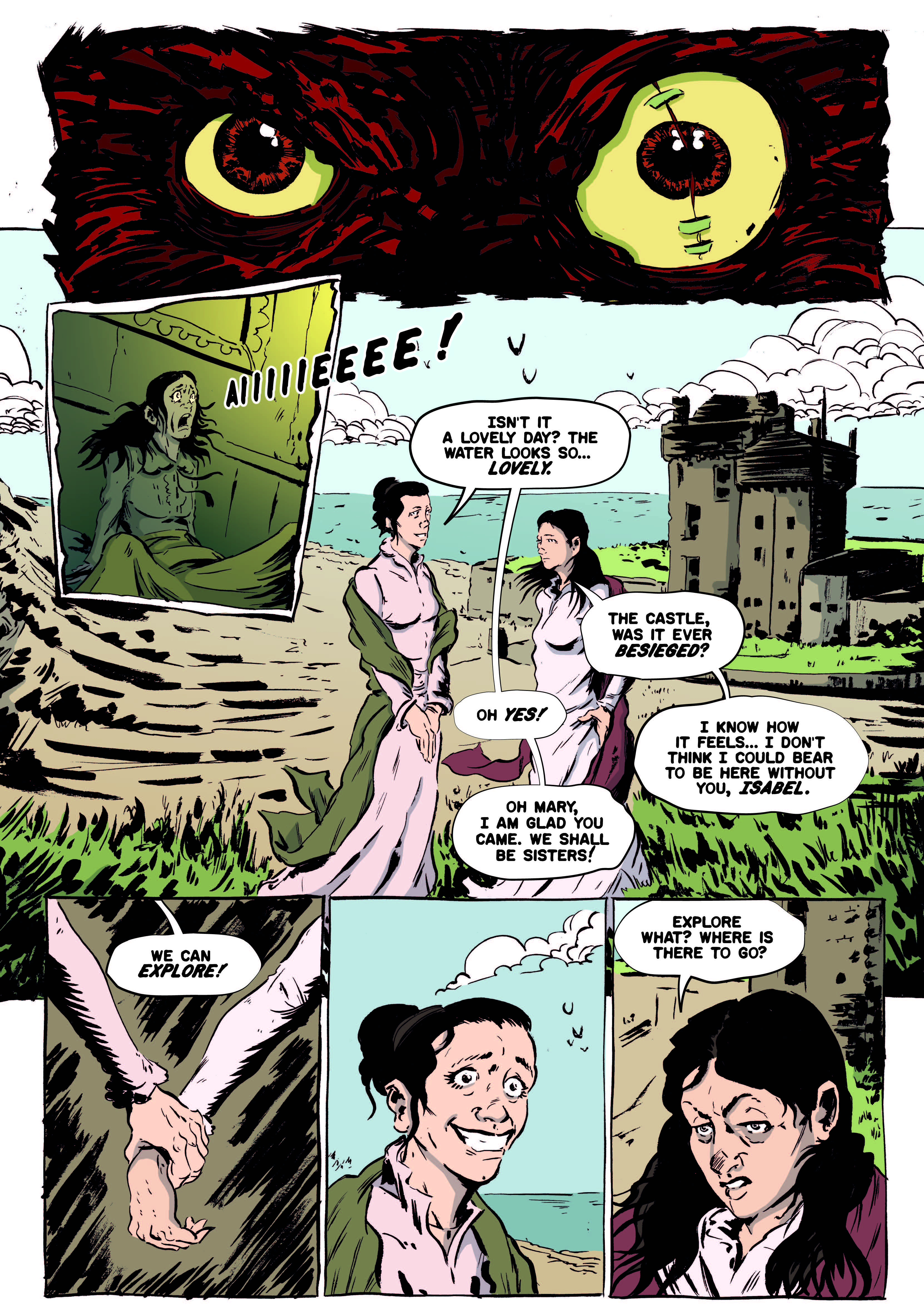
Frankenstein Begins, or Mary Shelley’s Dundee (UniVerse/Being Human, 2015), written by Chris Murray with artwork by Norrie Millar.
Discovery link to follow
The sequel, Frankenstein Returns (2018), was also produced as part of the Being Human Festival and coincided with the 200th Anniversary of the novel. ‘Arktos’, by Murray and Elliot Balson, summarises the story of the novel with an emphasis on scenes that are not usually depicted in adaptations. ‘Frankenstein Returns’, by Murray with artwork by Norrie Millar, follows the creature after the end of the novel, supposing that he survives the artic wastes, returns to Scotland via Orkney, and meets Mary Shelley in Dundee. It explores whether he can find a purpose beyond revenge.


Frankenstein Returns (UniVerse/Being Human, 2018), by Chris Murray and artists Norrie Millar, Elliot Balson, Ashling Larkin, Catriona Laird, and Dan McDaid.
A very different take on the creature and his relationship to his creator was offered by famed Scottish cartoonist Tom Gauld, who produced a cartoon in 2017 for the University of Dundee’s Literary Festival and subsequent Being Human Festival. Entitled ‘Frankenstein, Bonus Chapter’, the cartoon plays on the long-running debate about the name of the creature.
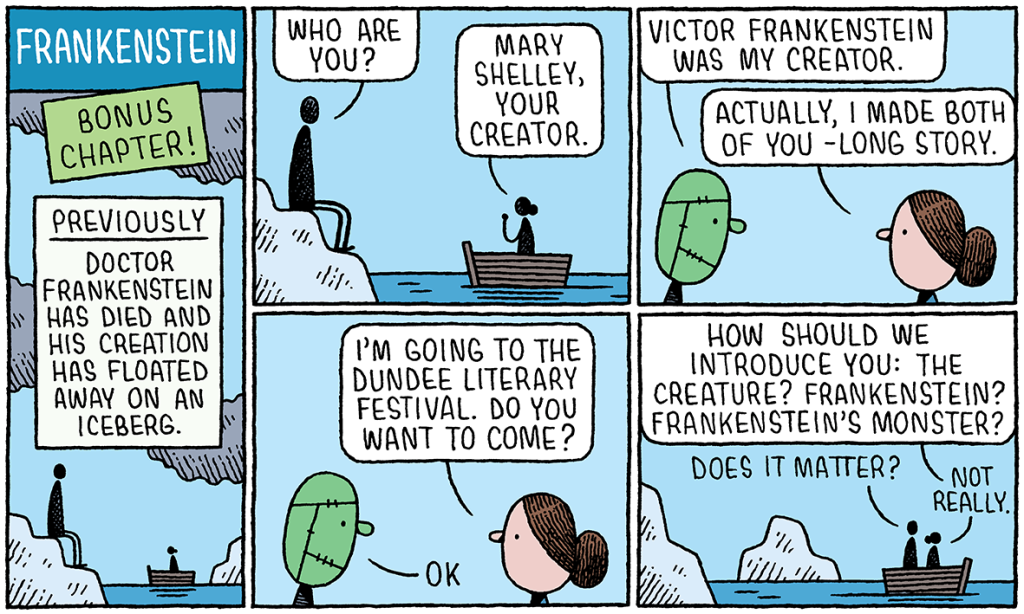
‘Frankenstein Bonus Chapter’ (2017) by Tom Gauld.
Having produced two comics that responded to Frankenstein Murray decided to combine these into one edition – Frankenstein’s Dundee (UniVerse, 2019). In addition to combining the stories written by Murray from the two previous Frankenstein comics this comic added some new material by Millar.


This work on Frankenstein culminated in the production of a Dundee edition of the novel edited by Dr Daniel Cool, designed by Phillip Vaughan, and featuring artwork by several comics artists, including Cam Kennedy, Ian Kennedy, Dan McDaid, and Norrie Millar. Their contributions reflect the long history of comics creators offering interpretations of the novel and the creature. This edition also featured a short essay by Murray on comics adaptations of the novel.
The following research was published based on this work:
Chris Murray, ‘Frankenstein in Comics and Graphic Novels’, in The Cambridge Companion to Frankenstein, edited by Andrew Smith (Cambridge: Cambridge University Press, 2016), pp.219-240, ISBN-10: 9781107450608.
Olaf Stapledon’s Odd John
In The British Superhero (2017) Murray examined the prehistory of British superheroes and discusses the representation of superbeings in British science fiction. A notable example is Olaf Stapledon’s Odd John (1935). Fascinated by the themes of Darwinism and eugenics in the story, Murray began scripting an adaptation of the novel. Enlisting the talents of artist Helen Robinson, this 80-page comic was completed in 2018 and was recognised by the Stapledon estate as the official comics adaptation of the novel.


The aim of the comic was to connect the tradition of the British superhero, where the heroic qualities of the superhero are often subverted, to a literary precursor which does something similar, with Stapledon’s novel presenting superhumans as fundamentally amoral. The narrator encounters a British reprint of Superman, in a change to the story that underscores the potential influence that the novel had on British comics creators who, often subvert the heroic ideals of American superheroes.
The following research featured some discussion of Odd John:
Chris Murray, The British Superhero (Jackson, USA: Mississippi UP, 2017), ISBN-978-1-4968-0737-3.
Karel Čapek’s R.U.R.
Murray collaborated with Comics Masters graduate and comics artist Nick Johnson in the creation of a new adaptation of Karel Čapek’s 1921 science fiction play R.U.R.: Rossum’s Universal Robots. The play, written in 1920 and first performed in January 1921, introduced the word ‘robot’ to the English language. In the play Helena, a representative of the League of Humanity, a group who seek freedom for the robots, visits the factory that produces the robots and meets the managers and chief scientists. She is appalled by their attitude towards the robots. A decade passes and new experimental robots are produced, but humanity is in decline and a war with the robots leads to the extermination of the human race.

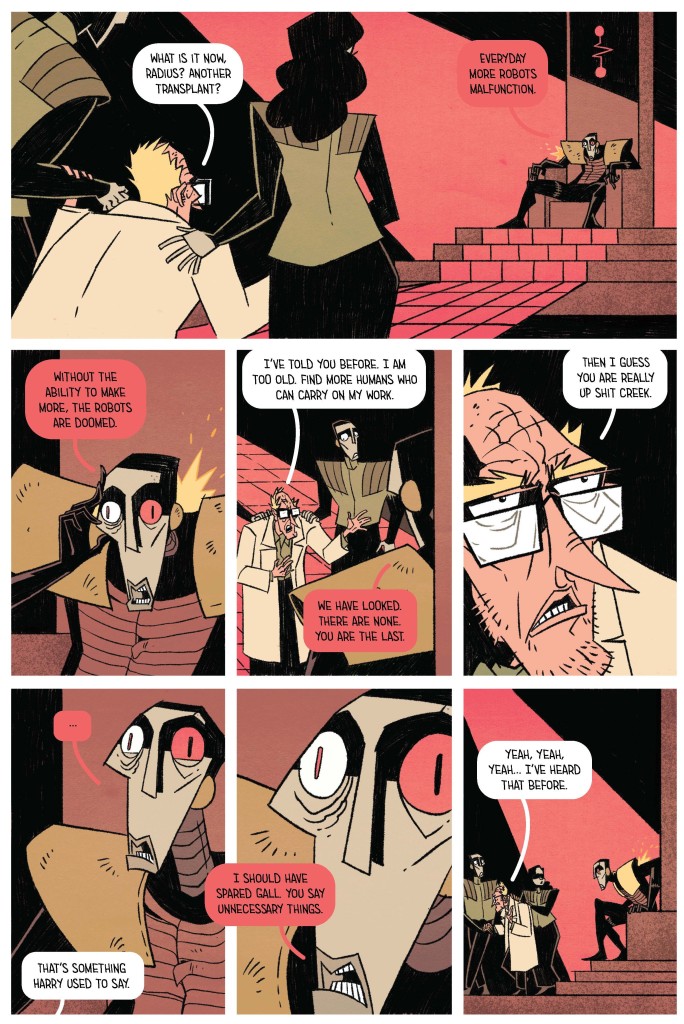
Murray, who wrote the script, says ‘the themes of Čapek’s wonderful play, which include prejudice, exploitation, technological innovation and capitalism are still very relevant to us 100 years after it was written’. He adds, ‘I am so impressed with Nick Johnson’s artwork, which combines influences from Constructivism, Futurism and mid-20th century animation. This collision of styles perfectly captures the odd tonal shifts of the play, and its striking imagery’.

R.U.R. Rossum’s Universal Robots (UniVerse/Being Human, 2021), with Nick Johnson.
You can view the trailer for the comic here:
Walter Scott
Dr Daniel Cook’s research into Sir Walter Scott’s shorter fiction and Murray’s research into the adaptation of literature into comics and graphic novels met in their collaborative work, Walter Scott’s Scottish Tales, launched in November 2021. Cook and Murray co-wrote the scripts, adapting three of Scott’s short stories set in Scotland – ‘Wandering Willie’s Tale’, ‘The Highland Widow’, and ‘The Two Drovers’. These scripts were illustrated by comics artists, Norrie Millar, Elliot Balson, and Julie Campbell. Also, included is ‘The Bride of Lammermoor’ by Helen Robinson. The cover by Dan McDaid was coloured by Phillip Vaughan. As Murray notes, ‘there has been many adaptations of Scott’s novels in comics, though many of them reveal the challenges of condensing those huge novels into comics, however, Scott’s shorter fiction does lend itself very well to adaptation into comics. The goal of this publication was to test this and to draw attention to the striking gothic elements in these short stories, as revealed by Dr Cook’s research’. This comic was funded by Cook’s Stephen Fry Public Engagement Award, as was released as part of the celebration of Scott’s 250th birthday. This followed on from an earlier comic, Reworking Walter Scott (2017) that invited comics creators to respond to works by Scott.


Reworking Walter Scott, various creators(UniVerse, 2017).
Discovery link to follow
Walter Scott’s Scottish Tales (UniVerse/Being Human, 2021), co-written by Murray and Cook with artwork by various artists.
The following research was informed this work:
Chris Murray, ‘Walter Scott in Comics’, in Studies in Scottish Literature 44.2 (University of South Carolina, 2019), ISBN-10: 1080511121.
H.G. Wells
Time and Space: An H.G. Wells Comics Anthology (UniVerse/Being Human, 2016), presented several adaptations and responses to works by H.G. Wells. It was produced in 2016 as part of the Being Human Festival and included the story ‘Battle of the Planets’written by Murray with artwork by Helen Robinson.
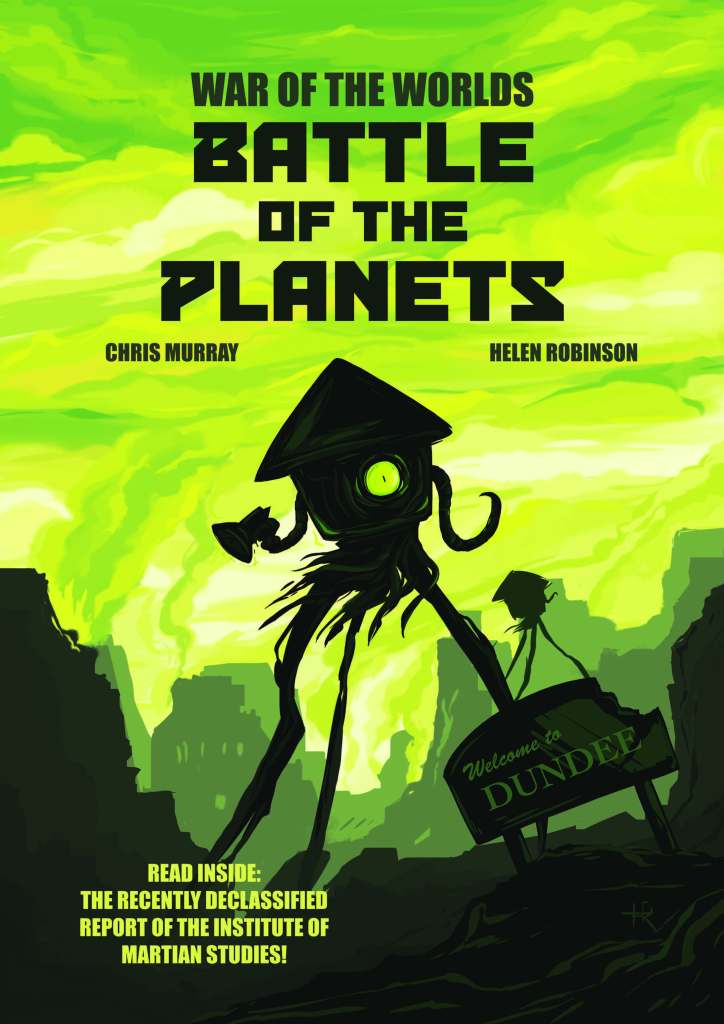

The story imagines that a Martian tripod lands in the Tay River and is recovered by a team of experts once the war is over. When the Martian escapes it terrorises the citizens of Dundee, but upon being recaptured it switches sides and helps the humans plan an invasion of Mars.
Jonathan Swift
In 2017 the Dundee response to the Being Human Festival’s themes of ‘lost and found’ focused on Jonathan Swift’s Gulliver’s travels. The anthology comic that resulted had a cover by Alex Ronald and featured a story called ‘The Borrowers’ by Murray and Monty Nero. This story explored the theme of adaptation using a similar metaphor and imagery employed by Swift, with the author beset by an army of tiny troublesome adaptors, or, as he calls them, ‘borrowers’.


‘The Borrowers’, in Swift at 350 (UniVerse/Being Human, 2017), with artist Monty Nero
H.P. Lovecraft
Murray has written on Lovecraftian horror comics, exploring the theme of fear of the unknown in the short wordless comic ‘Thing’, which appeared in Treehouse #6 (Treehouse Collective, 2015), with artwork by Norrie Millar.

In 2019 Murray worked with artist Garry Mac to produce ‘Dark Morbidities’ for the Being Human Festival comic, Water Worlds. This largely wordless sees Cthulhu leaving Mars in the wake of a Martian-made climate crisis only to find Earth isn’t much better.


‘Dark Morbidities’, (UniVerse/Being Human, 2019), by Murray and Garry Mac.
The following research informed this work:
Chris Murray and Kevin Corstorphine, ‘Co(s)mic Horror’, in New Critical Essays on H.P. Lovecraft, edited by David Simmons (Basingstoke: Palgrave Macmillan, 2013), pp.157-191, ISBN 10: 1137332247.
If you read any of our comics, please take a few minutes to complete a brief questionnaire. We would really appreciate your thoughts on the comics.
